Drug Overdose Deaths in the United States, 1999–2020
NCHS Data Brief No. 428, December 2021
PDF Version (501 KB)
- Key findings
- In 2020, the age-adjusted rate of drug overdose deaths in the United States was 31% higher than the rate in 2019.
- Drug overdose death rates were higher in 2020 than in 2019 for all groups aged 15 and over.
- Drug overdose death rates were higher in 2020 than in 2019 for all race and Hispanic-origin groups.
- Since 2016, rates of drug overdose deaths involving opioids have been highest for deaths involving synthetic opioids other than methadone.
- The rise in the age-adjusted rates of drug overdose deaths involving cocaine and psychostimulants with abuse potential that began in 2012 continued through 2020.
Data from the National Vital Statistics System
- The age-adjusted rate of drug overdose deaths increased 31% from 2019 (21.6 per 100,000 standard population) to 2020 (28.3).
- Among adults aged 35–44, the age group with the highest rates, drug overdose deaths increased 33% from 2019 (40.5) to 2020 (53.9).
- Rates increased from 2019 to 2020 for all race and Hispanic-origin groups.
- The rate of drug overdose deaths involving synthetic opioids other than methadone (such as fentanyl) increased 56%, from 11.4 in 2019 to 17.8 in 2020.
- From 2019 to 2020, the rate of drug overdose deaths involving cocaine increased 22%, from 4.9 to 6.0, and the rate of drug overdose deaths involving psychostimulants with abuse potential (such as methamphetamine) increased 50%, from 5.0 to 7.5.
Deaths from drug overdose continue to contribute to overall mortality and the lowering of life expectancy in the United States (1–4). This report uses the most recent data from the National Vital Statistics System (NVSS) to update statistics on deaths from drug overdose in the United States, showing rates by demographic group and by specific types of drugs involved (such as opioids or stimulants), with a focus on changes from 2019 to 2020.
Keywords: opioid, fentanyl, heroin, cocaine, methamphetamine, National Vital Statistics System
In 2020, the age-adjusted rate of drug overdose deaths in the United States was 31% higher than the rate in 2019.
- In 2020, 91,799 drug overdose deaths occurred in the United States for an age-adjusted rate of 28.3 per 100,000 standard population (Figure 1). The rate in 2020 (28.3) was 31% higher than the rate in 2019 (21.6).
- Overall, the age-adjusted rate of drug overdose deaths increased from 1999 to 2006, remained stable from 2006 to 2013, and generally increased from 2013 through 2020, except for a change in pattern between 2017 and 2019. The rate in 2018 (20.7) was significantly lower than the rate in 2017 (21.7), while the rate in 2019 (21.6) was significantly higher than the rate in 2018 and similar to the rate in 2017.
- From 2019 to 2020, the age-adjusted rate of drug overdose deaths for males increased from 29.6 to 39.5 and the rate for females increased from 13.7 to 17.1.
- For each year from 1999 through 2020, the rate for males was higher than for females.
Figure 1. Age-adjusted drug overdose death rates, by sex: United States, 1999–2020
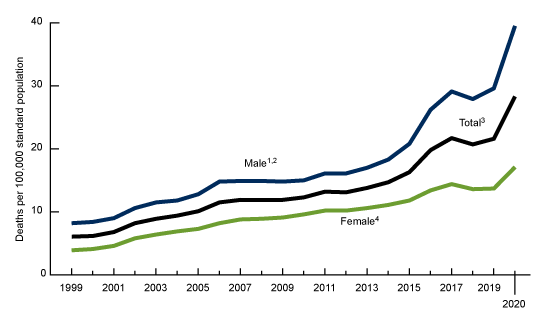
1Rates for males were significantly higher than for females for all years, p < 0.05.
2Significant increasing trend from 1999 to 2006, stable trend from 2006 to 2012, and increasing trend from 2012 through 2020, p < 0.05.
3Significant increasing trend from 1999 to 2006, stable trend from 2006 to 2013, and increasing trend from 2013 through 2020, p < 0.05.
4Significant increasing trend from 1999 through 2020, with different rates of change over time, p < 0.05.
NOTES: Drug overdose deaths are identified using the International Classification of Diseases, 10th Revision (ICD–10) underlying cause-of-death codes X40–X44, X60–X64, X85, and Y10–Y14. The number of drug overdose deaths in 2020 was 91,799. Access data table for Figure 1.
SOURCE: National Center for Health Statistics, National Vital Statistics System, Mortality.
Drug overdose death rates were higher in 2020 than in 2019 for all groups aged 15 and over.
- Among people aged 15 and over, the rate of drug overdose deaths increased from 2019 to 2020 for all groups (Figure 2).
- In both 2019 and 2020, rates were highest for people aged 35–44 (40.5 and 53.9 per 100,000, respectively) and lowest for people aged 65 and over (8.3 and 9.4).
- Rates increased 33% among people aged 35–44 (from 40.5 to 53.9) and 25–34 (from 35.6 to 47.3), and 27% among people aged 45–54 (from 36.9 to 46.9) between 2019 and 2020. Although people aged 15–24 experienced the largest percentage increase in drug overdose death rates between 2019 and 2020 (49%), they had the second lowest rates in 2019 (11.2) and 2020 (16.7).
Figure 2. Drug overdose death rates among those aged 15 and over, by selected age group: United States, 2019 and 2020
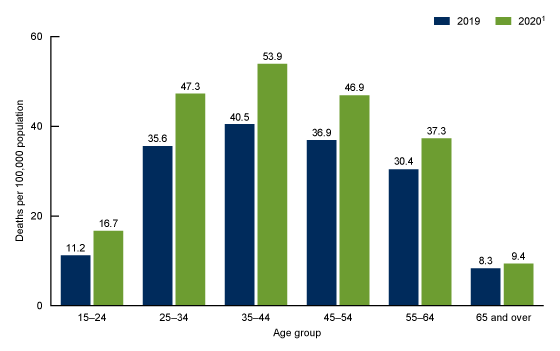
1Rates in 2020 were significantly higher than in 2019 for all age groups, p < 0.05.
NOTES: Drug overdose deaths are identified using the International Classification of Diseases, 10th Revision (ICD–10) underlying cause-of-death codes X40–X44, X60–X64, X85, and Y10–Y14. Access data table for Figure 2.
SOURCE: National Center for Health Statistics, National Vital Statistics System, Mortality.
Drug overdose death rates were higher in 2020 than in 2019 for all race and Hispanic-origin groups.
- From 2019 to 2020, the rate of drug overdose deaths increased for all race and Hispanic-origin groups (Figure 3).
- In both 2019 and 2020, rates were highest for non-Hispanic American Indian or Alaska Native (AIAN) people (30.5 and 42.5 per 100,000, respectively) and lowest for non-Hispanic Asian people (3.3 and 4.6).
- Among all race and Hispanic-origin groups, the largest percentage increases (44%) in drug overdose death rates from 2019 to 2020 were seen in non-Hispanic Black (from 24.8 to 35.8) and non-Hispanic Native Hawaiian or Other Pacific Islander (NHOPI) (from 9.5 to 13.7) people.
Figure 3. Age-adjusted drug overdose death rates, by race and Hispanic origin: United states, 2019 and 2020
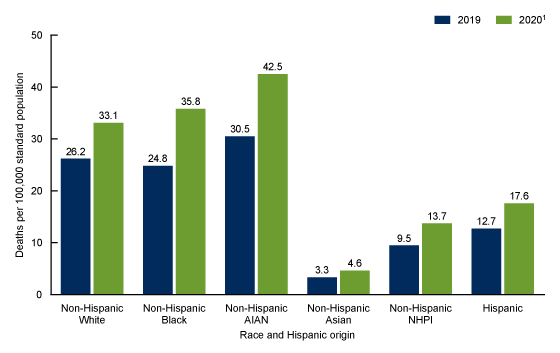
1Rates in 2020 were significantly higher than in 2019 for all race and Hispanic-origin groups, p < 0.05.
NOTES: AIAN is American Indian or Alaska Native. NHPI is Native Hawaiian or Other Pacific Islander. Drug overdose deaths are identified using the International Classification of Diseases, 10th Revision (ICD–10) underlying cause-of-death codes X40–X44, X60–X64, X85, and Y10–Y14. Access data table for Figure 3.
SOURCE: National Center for Health Statistics, National Vital Statistics System, Mortality.
Since 2016, rates of drug overdose deaths involving opioids have been highest for deaths involving synthetic opioids other than methadone.
- The age-adjusted rate of drug overdose deaths involving synthetic opioids other than methadone, which include such drugs as fentanyl, fentanyl analogs, and tramadol, increased from 1999 through 2020, with different rates of change over time (Figure 4). From 2019 to 2020, the rate increased 56%, from 11.4 to 17.8 per 100,000.
- The age-adjusted rate of drug overdose deaths involving heroin was stable from 1999 to 2005, increased from 2005 to 2016, and decreased from 2016 through 2020. The rate in 2020 (4.1) was lower than in 2019 (4.4).
- The age-adjusted rate of drug overdose deaths involving natural and semisynthetic opioids, which include such drugs as oxycodone and hydrocodone, increased from 1999 to 2010 but did not change significantly from 2010 through 2020. Compared with 2017 (4.4), rates decreased in 2018 (3.8) and 2019 (3.6) but increased in 2020 (4.0).
- The rate of drug overdose deaths involving methadone increased from 0.3 in 1999 to 1.8 in 2006 and 2007, decreased through 2017 (1.0), and increased in 2020 (1.1).
Figure 4. Age-adjusted rates of drug overdose deaths involving opioids, by type of opioid: United States, 1999–2020
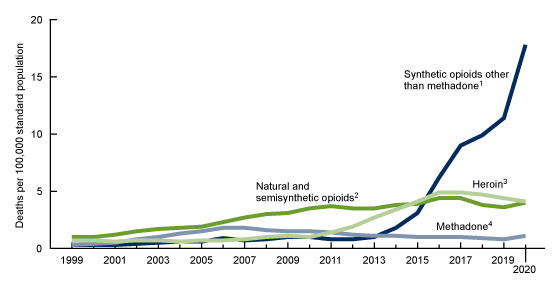
1Significant increasing trend from 1999 through 2020, with different rates of change over time, p < 0.05.
2Significant increasing trend from 1999 to 2010, and stable trend from 2010 through 2020, p < 0.05.
3Significant increasing trend from 2005 to 2016, with different rates of change over time, and significant decreasing trend from 2016 through 2020, p < 0.05.
4Significant increasing trend from 1999 to 2006, with different rates of change over time, significant decreasing trend from 2006 through 2017, and stable trend from 2017 through 2020, p < 0.05.
NOTES: Drug overdose deaths are identified using the International Classification of Diseases, 10th Revision (ICD–10) underlying cause-of-death codes X40–X44, X60–X64, X85, and Y10–Y14. Drug overdose deaths involving selected drug categories are identified by specific multiple-cause-of-death codes: any opioid, T40.0–T40.4 and T40.6; heroin, T40.1; natural and semisynthetic opioids, T40.2; methadone, T40.3; and synthetic opioids other than methadone, T40.4. Deaths involving more than one opioid category (such as a death involving both methadone and a natural or semisynthetic opioid) are counted in both categories. The percentage of drug overdose deaths that identified the specific drugs involved varied by year, ranging from 75%–79% from 1999 through 2013 and increasing from 81% in 2014 to 94% in 2020. Access data table for Figure 4.
SOURCE: National Center for Health Statistics, National Vital Statistics System, Mortality.
The rise in the age-adjusted rates of drug overdose deaths involving cocaine and psychostimulants with abuse potential that began in 2012 continued through 2020.
- The age-adjusted rate of drug overdose deaths involving cocaine increased from 1.4 per 100,000 in 1999 to 2.5 in 2006, decreased to 1.4 in 2012, and increased with different rates of change over time to 6.0 in 2020 (Figure 5). The rate in 2020 (6.0) was 22% higher than the rate in 2019 (4.9).
- The age-adjusted rate of drug overdose deaths involving psychostimulants with abuse potential, which include such drugs as methamphetamine, amphetamine, and methylphenidate, increased from 0.2 in 1999 to 0.4 in 2004, remained fairly stable through 2008, and increased from 2008 through 2020 (7.5), with different rates of change over time. The rate in 2020 was 50% higher than the rate in 2019 (5.0).
Figure 5. Age-adjusted rates of drug overdose deaths involving stimulants, by type of stimulant: United States, 1999–2020
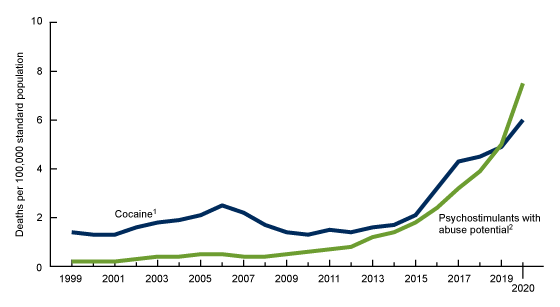
1Significant increasing trend from 1999 to 2006, decreasing trend from 2006 to 2012, and increasing trend from 2012 through 2020, with different rates of change over time, p < 0.05.
2Significant increasing trend from 1999 to 2004, stable trend from 2004 to 2008, and increasing trend from 2008 through 2020, with different rates of change over time, p < 0.05.
NOTES: Drug overdose deaths are identified using the International Classification of Diseases, 10th Revision (ICD–10) underlying cause-of-death codes X40–X44, X60–X64, X85, and Y10–Y14. Drug overdose deaths involving selected drug categories are identified by specific multiple-cause-of-death codes: cocaine, T40.5; and psychostimulants with abuse potential, T43.6. Deaths may involve more than one drug. The percentage of drug overdose deaths that identified the specific drugs involved varied by year, ranging from 75%–79% from 1999 through 2013 and increasing from 81% in 2014 to 94% in 2020. Access data table for Figure 5.
SOURCE: National Center for Health Statistics, National Vital Statistics System, Mortality.
Summary
From 2019 to 2020, the rate of drug overdose deaths increased for all sex, age, and race and Hispanic-origin groups. Overall, the age-adjusted rate increased 31.0%, from 21.6 per 100,000 in 2019 to 28.3 in 2020. From 2019 to 2020, the rate for males increased from 29.6 to 39.5, and the rate for females increased from 13.7 to 17.1. In both 2019 and 2020, adults aged 35–44 had the highest age-adjusted rate among people aged 15 and over. Although the greatest percentage increase in rates from 2019 to 2020 occurred among young people aged 15–24, rates also increased approximately 33% for adults aged 25–34 and 35–44. In both 2019 and 2020, rates were highest for non-Hispanic AIAN people. However, the greatest percentage increase in rates from 2019 to 2020 occurred among non-Hispanic Black and non-Hispanic NHOPI people.
The rate of drug overdose deaths involving different types of opioids and stimulants also increased from 2019 to 2020. The greatest percentage increases in rates occurred for drug overdose deaths involving synthetic opioids other than methadone (from 11.4 to 17.8) and psychostimulants with abuse potential (from 5.0 to 7.5). Increases were also seen in rates of drug overdose deaths involving natural and semisynthetic opioids, methadone, and cocaine. Of the drugs examined, only drug overdose deaths involving heroin had a lower rate in 2020 (4.1) than in 2019 (4.4).
Definitions
Drug poisoning (overdose) deaths: Includes deaths resulting from unintentional or intentional overdose of a drug, being given the wrong drug, taking a drug in error, or taking a drug inadvertently.
Natural and semisynthetic opioids: Includes such drugs as morphine, codeine, hydrocodone, and oxycodone.
Synthetic opioids other than methadone: Includes such drugs as fentanyl, fentanyl analogs, and tramadol.
Psychostimulants with abuse potential: Includes such drugs as methamphetamine, amphetamine, and methylphenidate.
Data source and methods
Estimates are based on the NVSS multiple-cause-of-death mortality files (5). Drug poisoning (overdose) deaths were defined as having an International Classification of Diseases, 10th Revision (ICD–10) underlying cause-of-death code of X40–X44 (unintentional), X60–X64 (suicide), X85 (homicide), or Y10–Y14 (undetermined intent). Of the drug overdose deaths in 2020, 91.0% were unintentional, 4.7% were suicides, 4.1% were of undetermined intent, and less than 1% were homicides. The type of drug(s) involved are indicated by ICD–10 multiple-cause-of-death codes: heroin, T40.1; natural and semisynthetic opioids, T40.2; methadone, T40.3; synthetic opioids other than methadone, T40.4; cocaine, T40.5; and psychostimulants with abuse potential, T43.6.
Race and Hispanic origin were categorized based on the Office of Management and Budget 1997 standards for federal statistical and administrative reporting (6). All of the race categories are “single race,” meaning that only one race was reported on the death certificate. Data shown for the Hispanic population include people of any race. Death rates for non-Hispanic Asian, non-Hispanic AIAN, and Hispanic people may be affected by misclassification of race and Hispanic origin on death certificates. This misclassification could result in underreporting of deaths for these groups by about 3% for non-Hispanic Asian and Hispanic people, and by an estimated 33% for non-Hispanic AIAN people (7).
Age-adjusted death rates were calculated using the direct method and adjusted to the 2000 standard population (8). Any differences between rates presented in this report are statistically significant (p values less than 0.05.) Trends in age-adjusted death rates were evaluated using the Joinpoint Regression Program (Version 4.8.0.1) (9). Joinpoint software fitted weighted least-squares regression models to the rates on the log transform scale. Analyses were set to allow a maximum of three joinpoints across the period, a minimum of three observed time points from any given joinpoint to either end of the data, and a minimum of four observed time points between any two joinpoints. The permutation tests for model (number of joinpoints) significance were set at an overall alpha level of 0.05 (10). Pairwise comparisons of rates (for example, age-adjusted rates for males compared with females and year-to-year comparisons) were conducted using a z test with an alpha level of 0.05 (8).
Several factors related to death investigation and reporting may affect measurement of death rates involving specific drugs. At autopsy, the substances tested for and the circumstances under which the toxicology tests are performed vary by jurisdiction. This variability is more likely to affect substance-specific death rates than the overall drug overdose death rate. The percentage of drug overdose deaths that identified the specific drugs involved varied by year, ranging from 75%–79% from 1999 through 2013 and increasing from 81% in 2014 to 94% in 2020. Additionally, drug overdose deaths may involve multiple drugs; therefore, a death might be included in more than one category when describing the rate of drug overdose deaths involving specific drugs. For example, a death that involved both fentanyl and cocaine would be included in both the rate of drug overdose deaths involving synthetic opioids other than methadone and the rate of drug overdose deaths involving cocaine.
About the authors
Holly Hedegaard and Merianne Spencer are with the National Center for Health Statistics (NCHS), Division of Analysis and Epidemiology. Arialdi Miniño and Margaret Warner are with NCHS, Division of Vital Statistics.
References
- Hedegaard H, Miniño AM, Warner M. Drug overdose deaths in the United States, 1999–2019. NCHS Data Brief, no 394. Hyattsville, MD: National Center for Health Statistics. 2020.
- Ahmad FB, Rossen LM, Sutton P. Provisional drug overdose death counts. National Center for Health Statistics. 2021.
- Xu JQ, Murphy SL, Kochanek KD, Arias E. Deaths: Final data for 2019. National Vital Statistics Reports; vol 70 no 8. Hyattsville, MD: National Center for Health Statistics. 2021. DOI: https://dx.doi.org/10.15620/cdc:106058.
- Barbieri M. The contribution of drug-related deaths to the US disadvantage in mortality.
Int J Epidemiol 48(3):945–53. 2018. DOI: https://doi.org/10.1093/ije/dyy288.
- National Center for Health Statistics. Public-use data files: Mortality multiple cause files. 2019.
- Office of Management and Budget. Revisions to the standards for the classification of federal data on race and ethnicity. Fed Regist 62(210):58782–90. 1997.
- Arias E, Heron M, Hakes JK. The validity of race and Hispanic-origin reporting on death certificates in the United States: An update. National Center for Health Statistics. Vital Health Stat 2(172). 2016.
- Murphy SL, Xu JQ, Kochanek KD, Arias E, Tejada-Vera B. Deaths: Final data for 2018. National Vital Statistics Reports; vol 69 no 13. Hyattsville, MD: National Center for Health Statistics. 2021.
- National Cancer Institute. Joinpoint Regression Program (Version 4.8.0.1) [computer software]. 2019.
- Ingram DD, Malec DJ, Makuc DM, Kruszon-Moran D, Gindi RM, Albert M, et al. National Center for Health Statistics guidelines for analysis of trends. National Center for Health Statistics. Vital Health Stat 2(179). 2018.
Suggested citation
Hedegaard H, Miniño AM, Spencer MR, Warner M. Drug overdose deaths in the United States, 1999–2020. NCHS Data Brief, no 428. Hyattsville, MD: National Center for Health Statistics. 2021. DOI: https://dx.doi.org/10.15620/cdc:112340.
Copyright information
All material appearing in this report is in the public domain and may be reproduced or copied without permission; citation as to source, however, is appreciated.
National Center for Health Statistics
Brian C. Moyer, Ph.D., Director
Amy M. Branum, Ph.D., Associate Director for Science
Division of Analysis and Epidemiology
Irma E. Arispe, Ph.D., Director
Kevin C. Heslin, Ph.D., Associate Director for Science
Division of Vital Statistics
Steven Schwartz, Ph.D., Director
Isabelle Horon, Dr.Ph.D., Acting Associate Director for Science